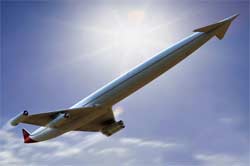Modern air travel is a marvel. It's also a source of endless delay, annoyance and planet-killing greenhouse gases. A proposed hydrogen-powered hypersonic airliner could change all that. The plane is Reaction Engines's A2 concept, a Mach-5 (3,400mph) craft for 300 passengers funded in part by the European Union's Long-Term Advanced Propulsion Concepts and Technologies project (Lapcat). Lapcat wants an airliner that can fly from Brussels to Sydney in less than four hours. If built, the A2 will do just that—without producing a trace of carbon emissions.
Engineers created the A2 with the failures of its doomed supersonic predecessor, the Concorde, very much in mind. Reaction Engines's technical director, Richard Varvill, and his colleagues believe that the Concorde was phased out because of a couple major limitations. First, it couldn't fly far enough. "The range was inadequate to do trans-Pacific routes, which is where a lot of the potential market is thought to be for a supersonic transport," Varvill explains. Second, the Concorde's engines were efficient only at its Mach-2 cruising speed, which meant that when it was poking along overland at Mach 0.9 to avoid producing sonic booms, it got horrible gas mileage. "The [A2] engine has two modes because we're very conscious of the Concorde experience," he says.
Those two modes—a combination of turbojet and ramjet propulsion systems—would both make the A2 efficient at slower speeds and give it incredible speed capabilities. (Engineers didn't include windows in the design because only space-shuttle windows, which are too heavy for use in an airliner, can withstand the heat the A2 would encounter.) In the A2's first mode, its four Scimitar engines send incoming air through bypass ducts to turbines. These turbines produce thrust much like today's conventional jet engines—by using the turbine to compress incoming air and then mixing it with fuel to achieve combustion—and that's enough to get the jet in the air and up to Mach 2.5. Once it reaches Mach 2.5, the A2 switches into its second mode and does the job it was built for. Incoming air is rerouted directly to the engine's core. Now that the plane is traveling at supersonic speed, the air gets rammed through the engine with enough pressure to sustain combustion at speeds of up to Mach 5.

